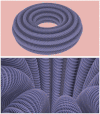Flat tori in three-dimensional space and convex integration
- PMID: 22523238
- PMCID: PMC3358891
- DOI: 10.1073/pnas.1118478109
Flat tori in three-dimensional space and convex integration
Abstract
It is well-known that the curvature tensor is an isometric invariant of C(2) Riemannian manifolds. This invariant is at the origin of the rigidity observed in Riemannian geometry. In the mid 1950s, Nash amazed the world mathematical community by showing that this rigidity breaks down in regularity C(1). This unexpected flexibility has many paradoxical consequences, one of them is the existence of C(1) isometric embeddings of flat tori into Euclidean three-dimensional space. In the 1970s and 1980s, M. Gromov, revisiting Nash's results introduced convex integration theory offering a general framework to solve this type of geometric problems. In this research, we convert convex integration theory into an algorithm that produces isometric maps of flat tori. We provide an implementation of a convex integration process leading to images of an embedding of a flat torus. The resulting surface reveals a C(1) fractal structure: Although the tangent plane is defined everywhere, the normal vector exhibits a fractal behavior. Isometric embeddings of flat tori may thus appear as a geometric occurrence of a structure that is simultaneously C(1) and fractal. Beyond these results, our implementation demonstrates that convex integration, a theory still confined to specialists, can produce computationally tractable solutions of partial differential relations.
Conflict of interest statement
The authors declare no conflict of interest.
Figures



References
-
- Nash J. C1-isometric imbeddings. Ann Math. 1954;60:383–396.
-
- Kuiper N. On C1-isometric imbeddings. Indag Math. 1955;17:545–556.
-
- Gromov M. A topological technique for the construction of solutions of differential equations and inequalities. Proc Intl Cong Math. 1970;2:221–225.
-
- Gromov M. Partial Differential Relations. Berlin: Springer; 1986.
-
- Eliashberg Y, Mishachev N. Introduction to the h-Principle. Vol. 48. Providence, RI: Am Math Soc; 2002. (Graduate Studies in Mathematics).
Publication types
MeSH terms
LinkOut - more resources
Full Text Sources
Miscellaneous

